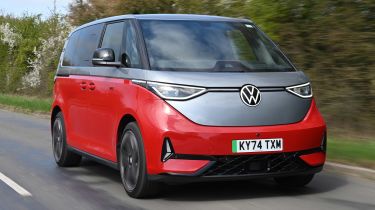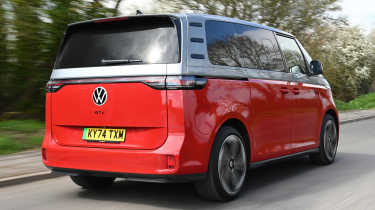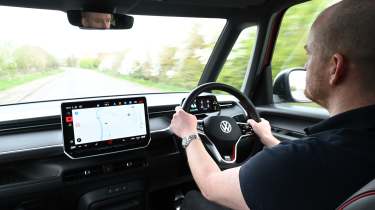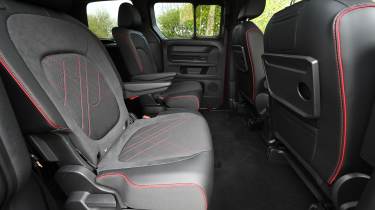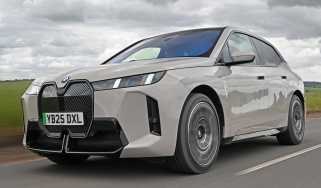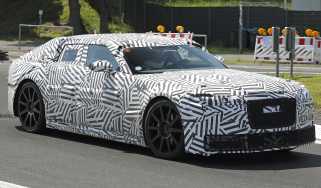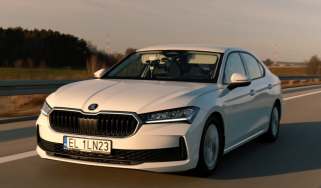New Volkswagen ID. Buzz GTX 2025 review: sporty MPV lacks wow factor
The flagship Volkswagen ID. Buzz GTX packs 335bhp, but the extra power doesn't provide extra thrills

Verdict
Making a sporty version of one of the least sporty passenger vehicles money can buy is something that doesn’t really make sense. In reality, it’s more of a trim level that happens to add more power rather than an out-and-out performance model, and given it's only slightly more expensive than the other options, it’s not completely pointless. Even so, we’d save the extra outlay required for the GTX and benefit from the extra range and smoother ride of the less potent options.
When reviewing cars at Auto Express, we want to give buyers the best possible advice we can, and that means we generally divide our own personal opinions about a car from how competent they actually prove to be.
At times, this can mean there are cars that we rate extremely highly if you’re buying with your head, but that we’d probably admit might be just a bit dull. Conversely, there are vehicles we drive that are incredibly likeable, but that we’d find hard to recommend for many sensible terms. So when we say that we think the Volkswagen ID. Buzz GTX looks incredibly striking and is very charming, you might be able to figure out where this review is going.
Used - available now

2019 Ford
Kuga
63,856 milesAutomaticPetrol1.5L
Cash £11,455
2022 Fiat
500
12,924 milesManualPetrol1.0L
Cash £10,400
2026 BMW
4 Series
26,030 milesAutomaticPetrol2.0L
Cash £25,997
2025 Audi
A5 Sportback
37,025 milesAutomaticDiesel2.0L
Cash £25,197Even at first glance, it’s easy to fall for the new range-topper of Volkswagen's eye-catching MPV. That iconic VW bus shape has been brought into the 21st century with fantastic effect - especially in the bold Cherry Red/Mono Silver split paint job of our test car – a combination exclusive to the GTX. Also GTX-specific are the 21-inch alloy wheels, new front grille design and more purposeful bumper.
Inside, the seats are finished in the brand’s ‘ArtVelour’ suede-like upholstery and highlighted with red stitching. Up above is a huge panoramic glass roof that’s electrically dimmable, while 30-colour ambient lighting illuminates the cabin when the night rolls in.
This six-seat model is hugely spacious, too. The captain-style chairs in the first two rows are supremely comfortable, and knee and head room are outstanding. The middle row can slide forward to grant those in the very back a similarly impressive amount of space. The boot is a little small with six on board, mind you - but is just about big enough for a decent supermarket shopping trip. Still, there’s always the five-seat model if you’d want to sacrifice a little back-seat luxury for more load carrying ability.
Colours and interior trimmings aside, however, all of these things are available in the existing ID. Buzz models. It’s the powertrain that’s the main change for the GTX.
Here, there’s a dual-motor set-up that produces 335bhp (an increase of 53bhp) and the same 560Nm of torque. Those sound like impressive numbers, but then you have to remember that there’s almost 2.8 tonnes for those motors to haul around.
That’s reflected in the acceleration numbers. The boost in power, plus drive being sent to all four wheels, is enough to drop the 0-62mph time by 1.6 seconds to 6.1 seconds. In reality, the GTX never feels that quick. There’s a steady surge of acceleration, but it never feels much more dramatic than the standard model.
This is a vehicle that is about as far removed from sporty as it’s possible to be, which becomes all the more obvious when you try to drive the Buzz with any enthusiasm. Despite the GTX badge having performance connotations, this isn’t a car that enjoys being pushed along a twisty road. Enter a corner too keenly and the nose will wash wide as the tyres struggle to contain that mass. There isn’t a huge amount of feedback from the steering or any of the other controls, either. These things are all fine in the regular Buzz, because it has no sporty pretensions whatsoever, but here it just makes you wish it was capable of more.
And if anything, you’re getting less - in more ways than one. For a start, there’s less comfort because those huge wheels add more fidget to the ride than you’ll get in any standard models. In a car with relaxation as one of its biggest strengths, that’s a compromise we’d prefer to do without.
The other way GTX buyers will get less is in terms of range. That extra potency in a straight line harms efficiency. Even with the most delicate of right feet, we struggled to ever breach the 3.0 miles/kWh mark, with motorway driving knocking it lower than that. In the real world, we were looking on course for a 210-mile range. The less potent model did get beyond that 3.0mi/kWh mark in our hands, even with temperatures that weren’t as warm, and therefore as flattering, for the range figure. The peak 185kW charging speeds are impressive, mind you, and the ability to manually precondition the battery before arriving at a charge point ensures that the peak figure is achievable when the battery is depleted enough.
In terms of trying to preserve that range through careful driving, we’d like to see a little more scope for adjusting the level of motor-regeneration on offer. The standard mode offers deceleration that is so gentle that even a slight downhill stretch will see the ID.Buzz gathering pace still, while the stronger ‘B’ mode increases the strength, but not enough to allow for one-pedal driving. Other VW Group MEB-based electric cars, such as the Audi Q4 e-tron, are available with steering wheel-mounted paddles, and we’d like to see the same here.
There is one practical benefit that the GTX can boast over its rangemates, though. That extra power has bumped up its towing capacity of a braked trailer to 1,800kg – a 200kg increase. However, given its real-world range when trailer-free, and the fact that public rapid charging spaces routinely fail to cater for electric vehicles that tow, it’ll only make sense for those that tend to heave trailers locally.
Prices for the GTX start from £67,535 in five-seat mode, with the six-seat version we’re driving here weighing in at just £150 more.
There's also a seven-seat model, which has a range of 295 miles thanks to its larger 86kWh battery. It also gets faster 200kWh charging, and given it costs £68,045 (just £360 more than the six-seater) and loses only 0.4 seconds over the 0-62mph dash, it’s the one we’d go for. If you have the space to park its near-five metre-long body, that is.
An added short-term draw to all Buzz models is VW’s current offer with Ovo energy, which grants buyers up to 30,000 miles of free charging over a three-year period. It’s available through Ovo’s Charge Anytime home energy package, and is available on vehicles ordered before the end of May.
| Model: | Volkswagen ID. Buzz GTX 4Motion 6-seat |
| Price: | £67,585 |
| Powertrain: | 2x e-motors, 79kWh battery |
| Power/torque: | 335bhp/560Nm |
| Transmission: | Single-speed, four-wheel drive |
| 0-62mph: | 6.1 seconds |
| Top speed: | 99mph |
| Range: | 252 miles |
| Charging: | 185kW (5-80% in 30 mins) |
| Size (L/W/H): | 4,712/2,211/1,937mm |
| On sale: | Now |

